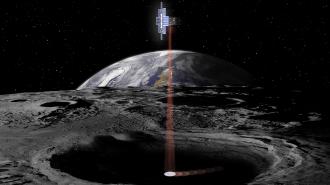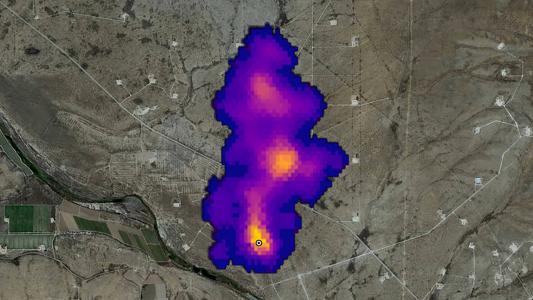NASA is sending a “Flashlight” to the moon to hunt for hidden lunar water — and its discoveries could shape future human exploration of the moon’s surface.
The challenge: NASA suspects that the floors of the permanently shadowed craters near the moon’s south pole are covered in a thin layer of water ice, but it doesn’t know exactly how much ice or how accessible it might be — and we’d really like to know.
“If we’re planning on sending astronauts there to dig up the ice and drink it, we have to be sure it exists.”
Barbara Cohen
“Although we have a pretty good idea there’s ice inside the coldest and darkest craters on the moon, previous measurements have been a little bit ambiguous,” Barbara Cohen, principal investigator for NASA’s Lunar Flashlight mission, said in 2020.
“Scientifically, that’s fine, but if we’re planning on sending astronauts there to dig up the ice and drink it, we have to be sure it exists,” she continued.
Lunar water: On or after November 22, NASA plans to launch Lunar Flashlight, a briefcase-sized satellite, aboard a SpaceX Falcon 9 rocket. The satellite’s mission is to identify surface ice on the floors of the moon’s shadowed southern craters.
To do that, it will use an instrument called a “laser reflectometer” to shine four lasers into the craters and measure the reflections. Water will easily absorb the lasers’ light, while bare rock will reflect it, so these measurements will help reveal the amount of lunar water inside a crater.

“We are going to make definitive surface water ice measurements in permanently shadowed regions for the first time,” said Cohen.
“We will be able to correlate Lunar Flashlight’s observations with other lunar missions to understand how extensive that water is and whether it could be used as a resource by future explorers,” she continued.
The mission: After launch, Lunar Flashlight will be sent well past the moon before being pulled back by gravity from the sun and Earth. The satellite will then settle into a near-rectilinear halo orbit that sees its distance from the moon range from 42,000 miles down to just 9 miles.
“The reason for this orbit is to be able to come in close enough that Lunar Flashlight can shine its lasers and get a good return from the surface, but to also have a stable orbit that consumes little fuel,” said Cohen.
Lunar Flashlight is expected to be able to pass above the moon’s southern craters 10 times over about 2 months. If it has enough propellant left after that, it could make additional orbits before the mission ends with a crash landing on the moon’s surface.
“We are going to make definitive surface water ice measurements in permanently shadowed regions for the first time.”
Barbara Cohen
First of its kind: In addition to helping NASA measure lunar water in shadowed craters for the first time, Lunar Flashlight will also be the first mission to use a laser reflectometer to hunt for water ice.
Additionally, it will be the first interplanetary spacecraft fueled by a “green” propellant that NASA says is less toxic, higher performing, and easier to store and transport than hydrazine, a fuel commonly used as a satellite propellant.
“A technology demonstration mission like Lunar Flashlight, which is lower cost and fills a specific gap in our knowledge, can help us better prepare for an extended NASA presence on the moon as well as test key technologies that may be used in future missions,” said John Baker, Lunar Flashlight project manager, in 2020.
We’d love to hear from you! If you have a comment about this article or if you have a tip for a future Freethink story, please email us at tips@freethink.com.






